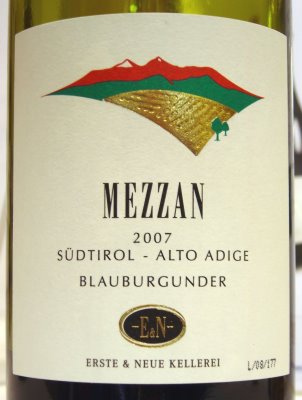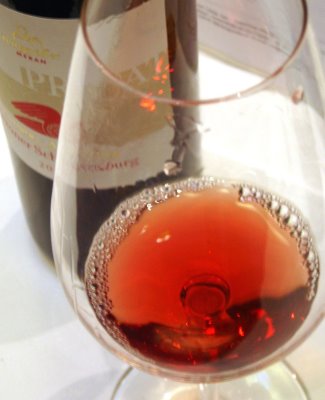Alto Adige tasting
Posted on 18 June 2009
Within the same promotional scheme I’ve blogged on here, a tasting of 72 Alto Adige wines was held here in Warsaw last Tuesday. 72 is the result of 12 times 6: six leading grape varieties were selected and a dozen wines representing each were poured. I’ve also tutored a parallel educational tasting. Here are a few highlights and recommendations.
 Pinot Bianco is one of my favourite grapes but it is not easy to make well. Aromatically it is medium intense at best, and tends to be shy and reductive in youth. Due to its elegance and backwardness it’s a notorious loser at comparative tastings. But it’s also easy to overdo when you introduce oak, later harvesting and other tricks. It’s what happened e.g. with the Josef Weger Pinot Bianco Maso delle Rose 2006, where a warm vintage and 50% large oak ageing changed citrusy freshness into oxidative butterscotch and orange jam. Overall the most successful wines were those showing restraint and typicity, such as two evergreen classics: the Cantina Terlano Pinot Bianco 2008 and Cantina S. Michele Appiano Pinot Bianco Schulthauser 2008. Both ever so reliable and living up to their reputation, made in a crisp mineral style with typicity and balance (the latter a bit softer and buttery). These are white wines I’d enjoy every day with or without food. The good surprise of the flight was the Otmar Mair Pinot Bianco 2007, from an estate hitherto unknown to me: a nicely perfumed wine with excellent intensity and balance on palate. Alois Lageder Pinot Bianco 2008, on the other hand, was the dud of the tasting: low in flavour and interest and absurdly expensive. What’s wrong with Lageder? His two latest vintages have been very disappointing across the board.
Pinot Bianco is one of my favourite grapes but it is not easy to make well. Aromatically it is medium intense at best, and tends to be shy and reductive in youth. Due to its elegance and backwardness it’s a notorious loser at comparative tastings. But it’s also easy to overdo when you introduce oak, later harvesting and other tricks. It’s what happened e.g. with the Josef Weger Pinot Bianco Maso delle Rose 2006, where a warm vintage and 50% large oak ageing changed citrusy freshness into oxidative butterscotch and orange jam. Overall the most successful wines were those showing restraint and typicity, such as two evergreen classics: the Cantina Terlano Pinot Bianco 2008 and Cantina S. Michele Appiano Pinot Bianco Schulthauser 2008. Both ever so reliable and living up to their reputation, made in a crisp mineral style with typicity and balance (the latter a bit softer and buttery). These are white wines I’d enjoy every day with or without food. The good surprise of the flight was the Otmar Mair Pinot Bianco 2007, from an estate hitherto unknown to me: a nicely perfumed wine with excellent intensity and balance on palate. Alois Lageder Pinot Bianco 2008, on the other hand, was the dud of the tasting: low in flavour and interest and absurdly expensive. What’s wrong with Lageder? His two latest vintages have been very disappointing across the board.
Alto Adige Sauvignon is the opposite of Pinot Bianco. Always performing exceedingly well at tastings, always satisfying at the dinner table. These wines strike a very happy balance between Loire-like minerality and intense Marlborough fruitiness. Thumbs up for the Cantina Bolzano Sauvignon Mock 2008 (a little technical but really tasty), the Cantina Colterenzio Sauvignon Prail 2008 (not abysmal depth but a perfectly tailored mid-priced example) and especially the Erste & Neue Sauvignon Stern 2008 (lots of content and balance, a delicious wine; a good surprise as I’m usually not so fond of this co-op’s wines). Here again I wasn’t too convinced by the more ‘ambitious’ interpretations of Sauvignon, such as Cantina Merano Sauvignon Graf von Meran 2007 where late harvesting pushed the vegetal notes of the variety into caricature, and then who needs a Sauvignon with 5.7g residual sugar?
Gewürztraminer is another Alto Adige classic. Actually a variety originating from the village of Tramin, from where it spread to other parts of Europe including Alsace and Germany. With its larger-than-life fruit and spicy exotic bouquet, it’s a grape you either love or hate. Actually Alto Adige is making it easier to love, delivering predominantly dry wines with relatively little alcohol (~14% vs. the more usual 15+% in Alsace these days) and good overall balance. Surely the case of the extremely typical and moreish Abbazia di Novacella Gewürztraminer 2008 which even shows some minerality (quite a challenge with Gewürztraminer). Among the more ambitious bottlings there were some misses – both the Cantina Cortaccia Gewürztraminer Brenntal 2007 (16%, 8.6g sugar) and Cantina Termeno Gewürztraminer Nussbaumer 2007 (15%, 7.2g) were rich and tasty but unbalanced towards heat and sugar – and hits. The latter included the Cantina Caldaro Gewürztraminer Campaner 2008 (14.5% and 6.8g proving a good balance, plus this is a really spicy, savoury wine with plenty of zest) and Cantina Terlano Gewürztraminer Lunare 2007. No surprise to those who already know this latter bottling but Lunare is an extraordinary creature of a Traminer: unalcoholic, mineral with fantastic depth and structure, it’s a wreckless naughty child that suddenly sits down to dinner with perfect manners and recites Tennyson from memory.
 Red wines, perhaps surprisingly to some, can be as successful as Alto Adige whites. Take those Pinot Noirs for example: they strike a happy middle ground between fruitiness and Burgundian seriousness, while avoiding the traps of their many German (alcohol) and New World (overripe fruit and no freshness) counterparts. Plus there is a variety of approaches, between the Germanic, herby, oaky, taut, ageworthy Klaus Pfitscher Pinot Nero Matan 2006, the concentrated and tightly mineral Abbazia di Novacella Pinot Nero 2007, the deftly oaked and delicious drinkable Erste & Neue Pinot Nero Mezzan 2007 and the brilliantly Burgundian, deep, structured & textured Manincor Pinot Nero Mason 2007 (likely the best red of the tasting). These Pinots really deserve to be better known.
Red wines, perhaps surprisingly to some, can be as successful as Alto Adige whites. Take those Pinot Noirs for example: they strike a happy middle ground between fruitiness and Burgundian seriousness, while avoiding the traps of their many German (alcohol) and New World (overripe fruit and no freshness) counterparts. Plus there is a variety of approaches, between the Germanic, herby, oaky, taut, ageworthy Klaus Pfitscher Pinot Nero Matan 2006, the concentrated and tightly mineral Abbazia di Novacella Pinot Nero 2007, the deftly oaked and delicious drinkable Erste & Neue Pinot Nero Mezzan 2007 and the brilliantly Burgundian, deep, structured & textured Manincor Pinot Nero Mason 2007 (likely the best red of the tasting). These Pinots really deserve to be better known.
Lagrein, on the other hand, is already quite well-known and successful. An endemic grape that’s proved nearly impossible to replant elsewhere, it yields a very modern kind of red with big concentration, lots of ripe black fruit aromas, smooth acids, ripe tannins, and a good relationship with new oak. A winning formula that’s occasionally marred by overextraction but that’s a marginal problem. Take the Tiefenbrunner Lagrein Linticlarus 2006. Cabernet with so much tannins would be undrinkable; Merlot with so much oak plain boring; yet this is really convincing and with potential to further improve. Eventually I preferred wines such as the Cantina Andriano Lagrein Riserva Tor di Lupo 2006 or K. Martini & Figlio Lagrein Riserva Maturum 2006 that showed the grape at its more mineral and terroir-driven. And even better, the deliberately lighter Gummerhof Lagrein zu Gries 2007 with its herby, crisp meaty fruit that reminded me of an honest old-style Tannat or Baga. Some uninspiring examples, too, such as the absurdly cassisey Cantina Cortaccia Lagrein Freienfeld 2005 that tasted like a Chilean Petit Verdot.
The wines that made my day, though, were made with another local grape called Schiava (or Vernatsch if you walk on the German side of this bilingual equation). It’s the opposite of Lagrein, being low in colour and alcohol, with little tannins to speak of, and making a wine that’s between a light red and serious rosé. Unfashionable as this may seem, it’s the real traditional style of wine here in the Dolomites; other than refresh your brain it’s an absolute cracker with the local continental, cabbage-meets-wild game cuisine. I really must drink more of these.
Cantina Bolzano S. Maddalena Huck am Back 2008 is a really good start at the variety with some mineral background and good texture. Hans Rottensteiner S. Maddalena Premstallerhof 2008 is lower on fruit but more mineral, and should improve with a year or two. Otmar Mair made another good Schiava 2007, as did Castel Salegg with its Lago di Caldaro Scelto Classico Bischofsleiten 2008 who even sneaked in some minerality. But the best was the Cantina Burggräfler Meranese Schickenburg 2008, a gorgeously refreshing wine with a sense of classicism and order without sacrificing drinkability.
Did I mention it was a brilliant tasting?


